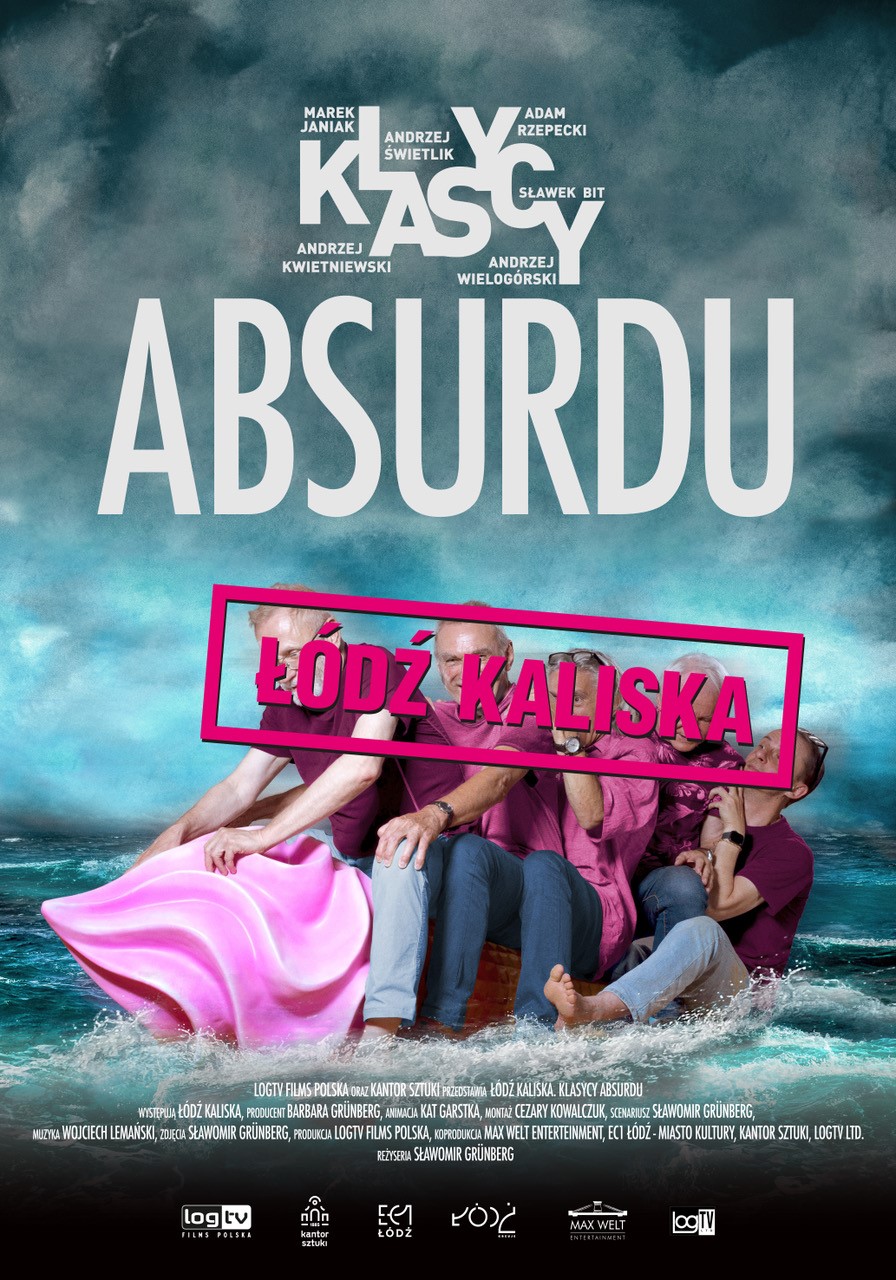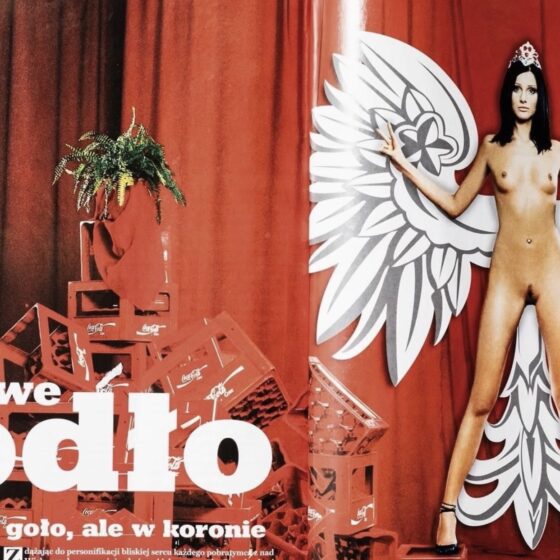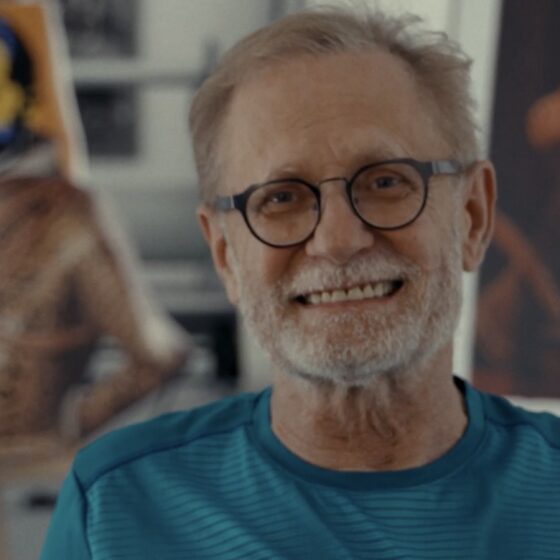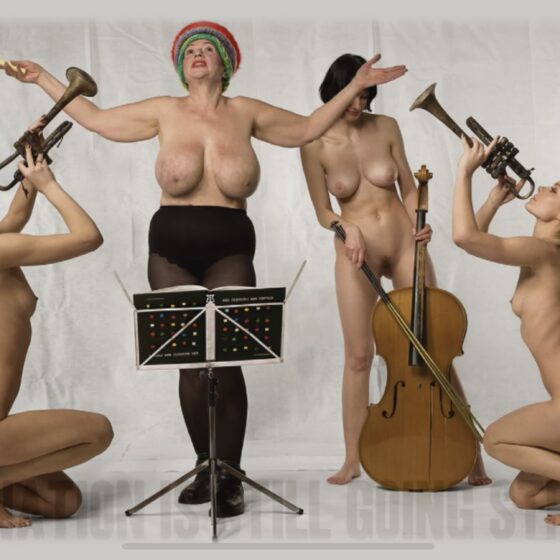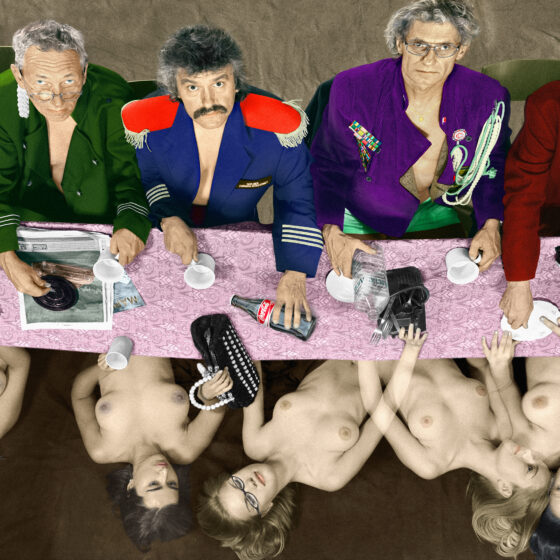LODZ KALISKA. Classic Artists of the Absurd (Łódź Kaliska: Klasycy Absurdu)
The documentary film “LODZ KALISKA. Classic Artists of the Absurd” presents a group portrait of one of the most ambitious art groups – Łódź Kaliska, which has remained consistently active in Poland for the last 44 years. The entirety of it the film relies on recent recordings and archival materials involving the artists of Łódź Kaliska as well as those either directly or indirectly connected with their professional and personal lives. Read more below.
ABOUT FILM
ABOUT FILM - POLISH VERSION
DIRECTOR'S TREATMENT
FILM CAST
CREDITS
SCREENINGS AND AWARDS
REVIEWS AND NEWS
FILM POSTER
FILM POSTER - POLISH VERSION
PRESS KIT
PRESS KIT - POLISH VERSION
ABOUT FILM
The documentary film “LODZ KALISKA. Classic Artists of the Absurd” presents a group portrait of one of the most ambitious art groups – Łódź Kaliska, which has remained consistently active in Poland for the last 44 years. The entirety of it the film relies on recent recordings and archival materials involving the artists of Łódź Kaliska as well as those either directly or indirectly connected with their professional and personal lives. The main focus of this film are the incredibly rich archival materials, both in photographic and film form, from Łódź Kaliska’s 44-year career, which are supplemented by contemporary interviews with the group’s members as well as clips of the group’s ongoing artistic endeavors.
The film “LODZ KALISKA. Classic Artists of the Absurd” is also a journey across the extraordinary and rich landscape of Poland’s art scene, starting in the 70s and ending in the present day. The film’s main characters are the founders and members of Łódź Kaliska. These perpetually energetic world-class artists – despite the turbulences in their country’s history – have remained loyal to and consistent with the art form which they practice with such success. The audience is given the opportunity to see the film’s subjects, the artists of Łódź Kaliska, in various situations, moments not only from their careers but from their lives as well. For the director himself, this is also a movie about friends with whom he has shared a common passion for photography and art as well as a sense of humor and mutual trust since the 70s. This film is an overview, which will undoubtedly contributes to a better understanding of Łódź Kaliska’s art and inspire in every viewer contemplations on the state of art itself and the ways in which it shapes a person and their personality. This is not a so-called ‘puff piece on Łódź Kaliska,’ but a film in which the statements of the subjects themselves as well as those from their environment tell the story in an open, honest and uncensored fashion. The audience also has the opportunity to hear statements from prominent experts on art history such as Prof. Anda Rotenberg, Prof. Maria Poprzecka and Prof. Ewa Nowina-Sroczyńska and their thoughts on Łódź Kaliska.
A special emphasis is placed on the use of never-before-seen archival materials. The creative animation that artistically draws all these elements together is an integral part of the film’s concept and brings additional elements of humor and reflection to the story. The exceptional music further complements the film’s themes.
Duration: 90 minut
ABOUT FILM - POLISH VERSION
Film dokumentalny „Łódź Kaliska. Klasycy absurdu” przedstawia zbiorowy portret jednej z najwybitniejszych grup artystycznych – Łódź Kaliska, działającej w Polsce nieprzerwanie od 44 lat.
Całość opiera się na aktualnych zdjęciach oraz na materiałach archiwalnych z udziałem artystów Łodzi Kaliskiej oraz osób bezpośrednio lub pośrednio związanych z ich życiem zawodowym oraz osobistym. Osią całego filmu są niezwykle bogate archiwalia, zarówno fotograficzne, jak i filmowe z 44-letniej działalności Łodzi Kaliskiej, dopełnione współcześnie zrobionymi wywiadami z członkami grupy oraz fragmentami aktualnie realizowanych działań artystycznych grupy.
Film „Łódź Kaliska. Klasycy absurdu” to także podróż po niezwykłym i jakże bogatym krajobrazie życia artystycznego Polski, poczynając od lat 70., a skończywszy na latach współczesnych. Bohaterami filmu są twórcy i członkowie Łodzi Kaliskiej, nieustannie pełni energii, światowej rangi artyści, którzy – pomimo różnych zawirowań w historii kraju – pozostali wierni i konsekwentni sztuce, którą z takim sukcesem uprawiają. Dzięki temu filmowi widz ma możliwość przyjrzenia się bohaterom filmu, artystom Łodzi Kaliskiej, w różnych sytuacjach i to nie tylko zawodowych, ale także życiowych. Dla reżysera jest to film po części o przyjaciołach, z którymi od lat 70. łączy go pasja do fotografii, sztuki oraz swoiste poczucie humoru i wzajemne zaufanie.
Jest to film pigułka, który bez wątpienia przyczyni się do lepszego poznania działań artystycznych Łodzi Kaliskiej, a także rozpoczęcia u każdego widza rozważań na temat kondycji sztuki jako takiej i jej wpływu na kształtowanie człowieka i jego osobowości. Nie jest to jednocześnie tzw. „laurka filmowa dla Łodzi Kaliskiej”, ale film, gdzie w samych wypowiedziach bohaterów filmu lub osób z jego otoczenia opowiedziana została ich historia w sposób otwarty, szczery i bez cenzury. Widz ma również okazję poznać opinie o sztuce tworzonej przez Łódź Kaliską, wypowiedziane przez wybitnych znawców historii sztuki, takich jak np. dr hab. Anda Rottenberg, prof. Maria Poprzęcka czy prof. dr hab. Ewa Nowina-Sroczyńska. Szczególny nacisk kładziony jest na wykorzystanie materiałów archiwalnych do tej pory nigdy wcześniej niepokazywanych. Kreatywna animacja stanowiąca artystyczny łącznik powyższych elementów filmu stanowi bardzo istotny element koncepcji filmu oraz wnosi do niego dodatkowe elementy humoru i refleksji. Wyjątkowa muzyka dopełnia treści filmu.
DIRECTOR'S TREATMENT
My documentary film’s scenario is based on current as well as archival materials featuring the film’s main characters, the members of the art group Łódź Kaliska as well as people directly or indirectly involved in the group’s activities.
The film revolves around several filmed so-called “meetings” of the group, held both in Łódź cafes as well as virtually – that is, around their novel deliberations on art as a whole as well as about their concrete plans for the upcoming weeks or months. Łódź Kaliska’s meetings make for unique lessons in art during which the members of this art group take us to a world which is close to their hearts. It’s a world that they want to share with the audience and fans of their medium, in which they “sculpt” and which they expertly interweave with both the economic and political realities of both the city of Łódź and the country in which they create and have been realizing themselves for the last 44 years.
The film that I offer is a journey into the extraordinary and rich lives of four artists who together for decades have made up the Łódź Kaliska art group. The audience will have the chance to see the film’s subjects in various situations not only in their professional but in their personal lives as well. This packed with energy, internationally recognized group’s past activities have not been devoid of controversy or conflicts with authorities and art critics. Conflicts from which – so far at least –they’ve always emerged victorious.
I’m convinced, that the film “ŁÓDŹ KALISKA. Classic Artists of the Absurd” will have no trouble finding an audience and will capture the attention of not just those who are interested in the arts, but people of all ages: the middle, older as well as the younger generation. I would like for this film to not leave the
viewer indifferent.
I address this film to both those who are unfamiliar with Łódź Kaliska, as well as to those who – like me – know their unique body of work and who now will be able to complement their image of them with that of a film which focuses on their sensitivity and clever observations of the reality which they often react to with controversial repartee.
I believe that this film will capture the interests of Poles as well as audiences outside of Poland because Łódź Kaliska – thanks to their exhibitions, happenings and awards – are world-class artists.
The knowledge that films really do have that great power to “change the world” is one of the most important reasons why I consider working on documentary films to be such an exciting and worthy endeavor. The films I make and undertake are sometimes difficult and touch on topics which are delicate, controversial and ambiguous. It’s good if they make people uncomfortable because I believe in discomfort, the kind that’s constructive and prevents conflicts. I hope that “ŁÓDŹ KALISKA. Classic Artists of the Absurd” will be a film which will inspire each and every viewer to reflect on the human condition, their place in the world and just what is important in life, what makes us who we are.
Filmmaking is also a great adventure, and the one thing that is the most enthralling in the work of a documentary filmmaker is that unexpected discovery. From the very first stages of working on this film, I was convinced that with the help of the camera I’d discover fascinating and until now undiscovered stories involving the film’s subjects and their lives. The viewers can judge for themselves whether I was successful.
The film definitely won’t be a so-called “puff piece on the artists,” but one in which the statements of the subjects themselves as well as those from their environment will tell the story in an open, honest and uncensored fashion. I am convinced that “ŁÓDŹ KALISKA. Classic Artists of the Absurd” will become an important film about not just art, but also about the brave and incredibly hard-working as well as often uncompromising artists.
The film is in part based on scenes filmed in the “direct cinema” style, formal interviews as well as selected archival materials in both film and photographic form from both film archives as well as private collections from around the world. Another important element of the film is its creative animation, a medium which I’ve used with some success in a few of my recent films such as Still Life in Lodz or Karski and the Lords of Humanity. The biggest visual challenge while working on this film was to combine the work of Łódź Kaliska with the work of the animators, so that the creative animation would not compete with the work of Łódź Kaliska, but would complement it in the most creative way. It’s a topic very in line with my doctoral thesis “THE ANIMATED DOCUMENTARY, EFFECTIVE FORMS OF BREAKING THE RULLES OF DOCUMENTARY FILMMAKING”, which I defended back in June 2019 at the Łódź Film School. A promotional event for the book under the same title took place in January, 2023, at the Cinema Museum of Łódź.
The photographs and videos included in the film were meticulously chosen from archival sources as well as from Łódź Kaliska’s private collections. In the film “LODZ KALISKA. Classic Artists of the Absurd” scenes from my film Burning Man, which I produced back in 2006 with members of Łódź Kaliska in the Nevada desert, have also been included.
Sławomir Grünberg
FILM CAST
• Sławomir Bit
• Małgorzata Błaszczyk
• Małgorzata Kapczyńska-Dopierała ‚Pynio’
• Jacek Franasik
• Marek Janiak
• Anna Krawczyk
• Andrzej Kwietniewski “Kwiecień”
• Joanna Łopat
• Zofia Łuczko
• Maria Poprzęcka
• Anda Rottenberg
• Adam Rzepecki
• Ewa Nowina-Sroczyńska
• Leokadia Szymańska
• Andrzej Świetlik
• Andrzej Wielogórski “Makary”
CREDITS
Director/Co-Producer/Cinematography/:
Sławomir Grünberg
Written by:
Sławomir Grünberg
Editor: Cezary Kowalczuk
Original Score:
Wojciech Lemański
Producer:
Barbara Grünberg, LOGTV Films Polska
Co-Producers:
Jacek Franasik – MAX WELT ENTERTAINMENT
EC1 Łódź – City of Culture
Kantor Sztuki
LOGTV, Ltd.
Post-production:
COLORPRO Agata Sterczewska
Animation:
Kat Garstka, Mikołaj Kula
Animation consultation:
Tom Niedźwiedź
SCREENINGS AND AWARDS
• “LODZ KALISKA. Classic Artists of the Absurd”, a movie directed by Sławomir Grünberg will premiere at the Panorama of the Polish Film at the Kraków Film Festival, Kino pod Baranami, Monday, 7 PM, May 29, 2023

REVIEWS AND NEWS
REVIEWS
“Łódź Kaliska: Classic Artists of the Absurd” by Slawomir Grünberg
Jan Hartman, Author & Philosopher
June 11, 2023
At the Burning Man festival in the USA, the characters in this film once made waves. Today, they have the chance for their second American success – thanks to an exceptional film “Łódź Kaliska: Classic Artists of the Absurd” by Slawomir Grünberg, a twice Emmy Award-winning documentary filmmaker. The 44 years of artistic activity of the five photographers, media artists and performers have produced a harvest that is abundant, entertaining and impressive at the same time. Their art, which ranges from staged photography to pastiches of various kinds to para theatrical actions, is the art of satire in a variety of guises and ‘weight categories’, from the simple fun to the sophisticated avant-garde. Socially engaged, progressive, but sometimes somewhat ambiguous in the way it deals with feminist themes.
Films about living artists tend to be a kind of narcissistic retrospective of their work, intended mainly for its enthusiasts. The “Łódź Kaliska” is quite different. There is no narcissism, no snobbery; instead, there is humor, Eastern European color and a wise, unblown reflection on art from the mouth of intelligent and witty artists and eminent academic art historians. Perfect editing, captivating animation and phenomenal music make this quite long documentary watchable without a moment’s boredom or even distraction.
The group of artist-performers, surrealist visual artists and mock-satirists, active since the 1970s under a witty name identical to the name of one of the railway stations in the industrial city of Łódź – “Łódź Kaliska” – was very well known and popular in its home country, i.e. communist Poland, wittily referred to as the “happiest barrack” in the Eastern Bloc, as well as in post-communist, democratic Poland of the nineties. It is worth getting to know them and it is worth getting to know the late People’s Republic of Poland (together with the glorious period of “Solidarity” movement of 1980/81) and the early Republic of Poland as seen through their eyes. Sometimes tragic, sometimes funny – Poland was a cradle of the revolution which broke out in the memorable year 1989.
In fact, seen from the perspective of Western Europe or North America, the world “behind the Iron Curtain” seemed very distant and alien, although not exotic. Sometimes it aroused fascination with some supposed combination of backwardness, authoritarianism and progressive ideas. However, the attention and sometimes the admiration of Western audiences was directed primarily towards the USSR, a power that commanded true respect. Only a few phenomenareached the West from that empire’s satellite countries, and on a mass scale mainly films from the Czech and Polish versions of the “new wave”. And yet so much was happening here! And Poland was in the peculiar and convenient situation that censorship was this much more lenient than in other so called communist countries. “Łódź Kaliska” can be seen as a comfortable stroll through the world of the leaning communist regime, where people can be – in spite of all – free and joyful.
There is a joy and spontaneity of slapstick in the activities of the Łódź Kaliska group. Grünberg’s film “Łódź Kaliska: Classic Artists of the Absurd”reflects this mood perfectly with its witty form. Everyone who watches it leaves the show in a better mood and with a greater distance to the world. The fleeting work of the five artists has been captured and commemorated in the coolest way they could have dreamed of.
Lodz Kaliska is a Woman
Bogdan Sobieszek Cultural Kaleidoscope
June 16, 2023
This film is like its characters – talkative, frivolous, provocative, but at the same time structured, disciplined and consistent in the pursuit of expressing reflections on art and life. This seems to be the main reason for its success.
The director Sławomir Grünberg managed to embrace (because he did not tame) an element that is inherently unpredictable and feeds on mockery, blowing up forms and conventions. He created a portrait, framing crazy artists (the picture frame is the dominant visual motif here). The film “Łódź Kaliska. Classic Artists of the Absurd” tells the story of a group of artist friends as if it were a rock band. Anyway, they are compared to the Rolling Stones not only because they have been creating their artistic world upside down for nearly half a century. These activities are often accompanied by an aura of scandal.
Grünberg gave the film the form of a chronologically ordered story about the origins and activities of the artistic group Łódź Kaliska. Its structure is determined by successive projects from the late 1970s to the present day. The sources are the artists themselves: Marek Janiak, Andrzej Świetlik, Adam Rzepecki and Andrzej “Makary” Wielogórski (the frames include Andrzej Kwietniewski, who left the group in 2010, and Sławomir Bit, who joined). Experts (including Maria Poprzęcka, Anda Rottenberg, Ewa Nowina-Sroczyńska) also speak to the camera. They remember the Muses, i.e. friends, collaborators, participants in artistic actions. This almost uninterrupted stream of words is joined by animations, which are a visual commentary, supplementing what is being discussed at the moment, or are a setting for archival materials.
This imposed plan is a system of landmarks in the chaos of ideas, images, emotions. It serves the legibility and clarity of the basic, fact-related, level of the message. Equally true is the climate of pranks, anarchy and obscenity that the characters themselves and their work brought to the film. The director, who was also shooting at the same time, must have had a difficult time with his imperative to maintain the discipline required in film production, even though he has known the boys since his studies at the Lodz Film School. However, he decided to keep the shots, especially those featuring Janiak, which invalidate the officiality and artificiality of the film interview situation, making the viewers’ relationship with the characters more direct. Such naturalization is the director’s introduction of the theme of the meetings as a framework for the story, a kind of interludes, a moment of breath in the flood of information, analyzes and interpretations. These are humorous mini-scenes in which Janiak, Świetlik and Makary create a film about Łódź Kaliska – they drop absurd ideas and write everything down in a notebook. Such behavior is characteristic of many activities of Łódź Kaliska in the public space, one can say: a permanent item on the agenda. Grünberg’s film, appropriated by the absurd energy of the members of the group, also becomes one.
The stylistic homogeneity of the image is preserved by animated fragments by Kat Garstka and Mikołaj Kula (in consultation with Tomasz Niedźwiedz, who collaborated with Grünberg on his previous films). Moving pictures maintained in the aesthetics of pop art, often reminiscent of Monty Python productions or the film “Yellow Submarine” by The Beatles, perfectly match the bizarre behavior of the characters in the story, they disarm them in a friendly way, and at the same time diversify the narrative. They come from the world of Łódź Kaliska, because they also often transform motifs and images that are characteristic of it. From the world of Łódź Kaliska, although in a more metaphorical sense, there is also the excellent music of Wojciech Lemański. The composer from Łódź, perfectly feeling the atmosphere of the grotesque and absurd, added an adequate audio track to the play of Łódź Kaliska. Thus, he gave this work another dimension. It sounded so good together, as if Lemański also belonged to the collective. Music combining various styles and approaches – from dynamic, humorous electro, through fair waltzes, to rock drums on the one hand and orchestral marches, heroism and lyricism on the other. The sounds fit perfectly into the image, ironically contrasting or exaggerating the meaning of the presented scenes and words. The message gained additional energy and pace, worthy of the artistic element it concerns. And please – although it may be hard to imagine – we saw Łódź Kaliska with a turbocharger.
Sławomir Grünberg’s film is like a tongue-in-cheek monographic lecture. Even the expert Prof. Maria Poprzęcka speaks with an ironic (?) smile so that we are not sure if she is serious. But only in this way can the film give the viewers a chance to experience (and understand) the phenomenon of Łódź Kaliska. Artists are still active and do not think about retirement. The film is not only a reminder of their past projects, but also a harbinger of their next ones, inspired by the increasingly complicated Polish modernity. We watch them in action – provocative, exaggerated in gestures and words, often causing the recipient a sense of embarrassment or disorientation. Mostly, however, they are able to generate a metaphorical, perverse message, a scathing commentary on social reality, out of this chaos devoid of content, an empty prank without an idea, a total mess.
This – as described in the film by Prof. Ewa Nowina-Sroczyńska – carnival performed by the artists of Łódź Kaliska has its limits. Mockery, provocation and negation end when the world denies them the meaning and respect they deserve. With some surprise, we find that they also have a deeply human need to be accepted and appreciated. Scandals want to be taken seriously, they want access to artistic salons. Although after years – I have the impression – a lot has changed for the better: retrospectives of their work have been held in prestigious halls, they have become classics, to this day they feel misunderstood and omitted, even by patrons. They bitterly admit that they implemented their projects with their own money. Jacek Franasik appears in Grünberg’s film – the first sponsor in the history of the group, who is also a co-producer of “Łódź Kaliska. Classic Artists of the Absurd.”
The misunderstanding of the artists of Łódź Kaliska concerns mainly their attitude towards women. The group’s work can be viewed as an endless dialogue with feminism. – A woman is the most beautiful thing in the world – declares Marek Janiak at the beginning of the film. However, no one who has come into contact with the works of Łódź Kaliska is surprised by the allegations of instrumental treatment of women, turpistic depiction of the female body, making large breasts a fetish. Many projects use female nudity – e.g. staged photographs, new versions of classic paintings (Muzzeum Łódź Kaliska 1997–2002), “The Winged Eagle”, i.e. a naked woman integrated into the Polish emblem, used on the cover of “Playboy” (2004), the project “May Men Rot” (2009), in which typically male jobs are performed by a crowd of naked women, or a film made by Grünberg in 2006 in the Nevada desert (“Burning Man”), where artists direct hundreds of naked female cyclists. As if in spite of this, women willingly cooperate with Łódź Kaliska, in the film, apart from Franasik, there are only women who comment and remember (only well). At the end, in defense of the artists, prof. Maria Poprzęcka, as if definitively invalidating the accusations, states that Łódź Kaliska in its actions, photos and films “empathizes with the subjectivity and agency” of women, that Łódź Kaliska is a woman.
Life probably added quite a postscript to Grünberg’s film. After the premiere screening in Łódź in June 2023, a lady sitting in the first row asked the artists why the women building the road in their project “May Men Rot” are naked and why there are no women in the group (I’m not sure if it was a substitute ). Marek Janiak replied: “Since there were no men there, they didn’t have to be dressed. Why isn’t there a woman in the group? We ourselves have a lot of the feminine element in us.”
Premiere of a documentary about the artistic group Łódź Kaliska. There is no Łódź without Łódź Kaliska
Darius Pawlowski, Dziennik Łódzki
June 9, 2023
The artistic group Łódź Kaliska has a full-length documentary devoted to its work. Important and extremely needed.
The film “Łódź Kaliska: Classic Artists of the Absurd” was made by Sławomir Grünberg, a longtime friend of the group’s members, a respected director, producer and cameraman of documentary films. And since this is a “friendly” film, the production is filled with a kind, warm, noble look at the phenomenon of the group and its 44-year history, noticing the causes of all perturbations related to the activity of Łódź Kaliska in the so-called external factors, and not in the conduct and choices of individual members, as it is said today, of the collective.
Formally excellent (the artist uses numerous archival materials and brilliant animations by Kat Garstka), the well-edited film, enriched with the phenomenal music of Wojciech Lemanski from Lodz, is watched with real pleasure, savoring how much has been managed to fit in this project – with the feeling of how significant elements deliberately resigned… The preserved chronology of events, with the possibility of looking at the subsequent stages of the group’s activity from a distance, mean that with each story mentioned here you can revel in the ingenuity, originality and constant freshness of the Łódź Kaliska artists’ view of reality and its relationship with art.
In the production, almost all members of the group mention their activities and point to their context at that time, the whole is enriched by the opinions of art history experts, such as Dr. Andy Rottenberg, Prof. Maria Poprzęcka and Prof. Dr. Ewa Nowina-Sroczyńska. There is no shortage of the legendary muses of Łódź Kaliska and famous places associated with the group, such as the Strych in a tenement house at 149 Piotrkowska Street, or the Łódź Kaliska pub at 102 Piotrkowska Street displaying the group’s works, where many invariably feel at home.
The film accurately emphasizes the artists’ choice of Łódź Kaliska – to some extent determined by their expulsion in 1979 from the first plein-air they participated in, in Darłówek, on the third day of its duration – their own creative path and consistent swimming against the current of officially supported art trends. This made it possible to build an absolutely unique artistic strategy, to pierce the balloons of ideological and moral seriousness, while at the same time exposing other groups – from patriots to feminists. And only the film’s insistent explanation of their actions with the latter causes the creators’ power of resistance – who argued that “breasts are nature, the rest is industrialization” – to the prevailing narratives of the present, slightly weakened and put against the wall.
“Łódź Kaliska: Classic Artists of the Absurd” is an extremely important and much needed film, because it not only sanctions the members of the group as classics, preserves their achievements in a great form accessible to various viewers, but will also be a discovery for many. Sławomir Grünberg himself admitted this to some extent, saying: – It seemed to me that after following the artistic activity of Łódź Kaliska for over 40 years, I had a good insight into what they created. It turned out, however, that I was wrong, because the existence of some works I was completely unaware of, and others I knew only superficially.
The official premiere of the film took place at the 63rd Krakow Film Festival, in Łódź, the film was shown by the Charlie Cinema. Now, before the production, a journey through various festivals and shows in prestigious halls. The film’s producer, Barbara Grünberg, announces that her dream is to present the painting at the Venice Biennale. And it is the most appropriate place for Łódź Kaliska.
FILM POSTER

FILM POSTER - POLISH VERSION
